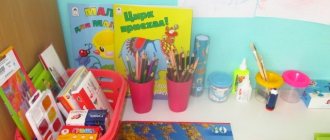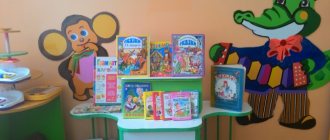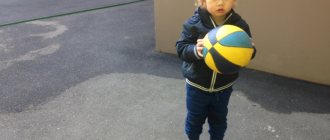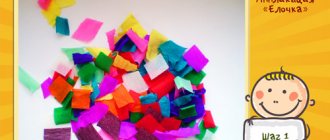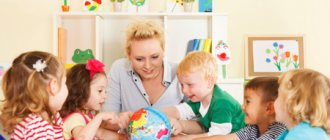Collective creative activities in kindergarten
Author: Chernyshova Svetlana Nikolaevna
Collective creative activities in kindergarten
The most complex and least developed type of activity is creativity. It is known that children's creativity is a unique phenomenon. If the mind, (knowledge, thinking, imagination), character (courage, perseverance), feeling (love of beauty, fascination with image, thought) take part in the creative activity of adults, then we must cultivate these aspects of the child’s personality in order to successfully develop creativity in him.
Collective creative activities are of great importance for the formation of creative abilities.
Collective creative activity
is an effective method of education, training and development of students, based on positive activity, collective authorship and positive emotions.
Collective creative activity
- these are not matters for the children and not only in the name of their education, these are the affairs of the children themselves, or rather, of the team, of which the adult also becomes a member.
The introduction of new Federal State Educational Standards (Federal State Educational Standards) in preschool education dictates the updating of the content and forms of work with children. Integration of educational areas is the scientific and methodological basis of the Federal State Educational Standard for Education. And creative activity, as a rule, connects the following educational areas: cognition, artistic creativity, communication, socialization, security.
Working with the children of my group “Kapelka”, I paid special attention to collective creative activity. The reason was that for some time my students suffered failures in events where they had to collectively “fight” for prizes: the children did not cooperate, but competed, everyone was for themselves, and there was no “team spirit” in the team. It was necessary to somehow unite the children, interest them, explain them... I found a way out of this situation in collective creative activities
, through which the group’s staff can be united and children’s creativity can be developed.
Collective creative activities differ from each other in the nature of their common practical concern.
Artistic collective creative affairs . Goal: to develop the artistic and aesthetic tastes of children; strengthen the craving for spiritual culture, art and the need to discover beauty to other people; awaken the desire to try yourself in creativity; cultivate receptivity, nobility of soul; enrich the inner world of a person (modeling, appliqué, drawing).
Labor collective creative affairs. Goal: to enrich children’s knowledge about the environment, to develop views on work as the main source of joy, to cultivate the desire to contribute to the improvement of reality, as well as the ability and habit to really, in fact, care for people near and far, to work independently and creatively for benefit and joy (Events were held: “Gift to Friends”, “Labor Surprise”, “Book Workshop”).
Cognitive collective creative activities. Goal: to form the needs for knowledge, a conscious, enthusiastic, effective attitude towards the immediate sources of discovery of the world. Cognitive collective creative activities have the richest opportunities for the development in preschoolers of such personality qualities as determination, perseverance, observation and curiosity, inquisitiveness of mind, creative imagination, comradely thoughtfulness, spiritual generosity (Events: “Evening of fun tasks”, “Evening of solved and unsolved mysteries” ", excursions, projects "Miracle City", "Nettle", "Take care of the birds").
Sports collective creative activities. Goal: to develop a civil attitude towards the sports and recreational side of life, towards physical culture, towards oneself as healthy and seasoned citizens of society; develop speed, agility, endurance, resourcefulness and perseverance, courage and courage, collectivism and discipline (Events: “Fun Starts”, “Call of the Jungle”, “Ski Track of Russia”, “Cross of the Nation”).
Social and patriotic collective creative deeds. Goal: to strengthen the civic attitude towards your family, school, big and small homeland; expand and deepen your knowledge about the history and culture of your country, learn to see and understand the beauty of life (Events: “Day of Knowledge”, “New Year’s Holiday”, “Defenders of the Fatherland Day”, “International Women’s Day March 8”, “Victory Day”, project "My Family")
Organizing collective creative activities. Any practical activity becomes collective and creative only in lively joint organizational activities (Events: students’ birthdays, drawing and craft competitions).
Each collective creative activity can take from several minutes to several weeks, depending on the goals, nature and composition of the participants.
Using all types of collective creativity in their work, I noticed that children learned to coordinate their actions and opinions, be attentive to the feelings and emotions of other people, plan their actions, and determine their sequence.
All my work on developing collective creativity in children has yielded good results. My students became winners in territorial events: Municipal festival “This kind fairy tale”, “The most beautiful” - Grand Prix; Municipal festival “Russian Soul” - 1st place; Municipal festival of children's creativity "Rainbow of the Planet of Childhood" Grand Prix and two first places.
And also my children are active participants and winners of regional, all-Russian and international competitions and events: All-Russian event “Memory Tree”; 5 All-Russian Science Festival NAUKA 0+ Children's drawing competition “The World of Science through the Eyes of Children” - 1st place; All-Russian creative competition for preschoolers “Feathered Friends” - 1st and 2nd places; International Children's Art Competition "Paints", Drawing Competition "The World through the Eyes of Children" - II, III places; IV International Children's Drawing Competition "Children on the Planet Are Friends", Open interregional tournament of abilities "RostOK-SuperUm" for children of senior preschool age - I, II, III places.
I am proud of my students and the results of the work done.
Educator: S.N.
Chernyshova comments powered by HyperComments
How to play up the beginning of a lesson in an interesting way
At the age of four or five years, children do not yet separate play from direct educational activities, therefore, in order to interest them in a creative activity as much as possible, the teacher must think through an exciting start to the lesson. For example, a group may receive a letter from a good wizard. He has a wonderful garden with unusual trees, on which fabulously beautiful flowers bloom and delicious fruits grow. But due to the tricks of the evil witch, the flowers did not bloom this year. The kids should help - decorate the trees with their strange flowers.
Another option is that a girl Masha comes from a fairyland to visit the children (a doll is on display). She tells an interesting story. One day she went for a walk in a wonderful forest to admire its beauty: all the trees there were bright and elegant. And so she walked and met one sad tree: it was worried that it did not have beautiful flowers and fruits. Masha felt very sorry for the tree, but she didn’t know how to help it—she couldn’t do it alone.
When telling preschoolers such stories, it is necessary to provide them with illustrations for them - pictures depicting magical nature. These can be gardens and clearings where apple trees with huge fruits grow, trees with soft lilac foliage, bizarrely shaped plants, among which fairy-tale characters (fairies, unicorns, anthropomorphic insects, etc.) walk.
Photo gallery: pictures depicting magical scenes of nature
A tree with huge roots and wonderful fruits
Apple tree with huge delicious apples
Fairies and unicorns are located between the delicate trees
Multi-colored trees, among which cute bugs and birds rest
Kids always love to transform into representatives of some profession, fairy-tale heroes. Therefore, they will enthusiastically accept the teacher’s offer to become wizards for a while and create the image of a magical garden, which they can populate at will with unusual trees, flowers, birds, beetles, and butterflies.
On the eve of the lesson, it is good to invite the children to complete puzzles on the theme “Garden”.
Before a creative activity, it is good to offer preschoolers puzzles on the relevant topic.
You can start a visual arts activity with a short fairy tale or an episode from a suitable work (after all, too long a story will tire the children). For example, in the fairy tale story “The Magic Garden” by Elena Zheryakova, the girl Lilya has a dream in which she goes to a wonderful castle and meets her cat there. It turns out that the animal can talk and invites its owner to take a walk in the garden. Lilya sees beautiful flowers: some her mother grew at the dacha, and others she has never seen before. There was a wonderful smell in the garden, and a bright rainbow shone in the sky. The girl's mood became simply wonderful. The cat told her about the names of flowers and various interesting facts from the life of plants (it was not for nothing that in the summer they took her with them to the dacha). She also told Lila that this garden is magical: if you look at the flowers and inhale their wonderful aroma, then all the bad things will be forgotten.
The following fairy tale with the same name, which was invented by schoolgirl Margarita Efimova, is also suitable for the lesson. One family had a large garden where various fruit trees grew: apple and pear trees, plums and apricots. And one day beautiful birds flew there. The son grabbed a stick and began to drive them away. The father scolded the boy. And the next day the garden became sad, and all the fruits became bitter. It turns out that the birds were magical and sang magical songs to the trees, but now they are offended and no longer come. Mom told her son that he should go into the forest, find the birds and apologize to them. The boy did so, and then the garden came to life again and the fruits became tasty.
The story of Elena Pishchulina-Volkova “A Tale of Love” also deserves attention. Magic Garden" (intended for children and adults). Here we are talking about a wonderful, kind garden that talked with the sun.
“Sunlight took Joy and Warmth by the hands (although a little warmth always remained to warm the conversation) and walked quietly and calmly through the Garden. The warmth caught up with them a little later, having already warmed the communication between the Garden and the Sun, it hurried after Joy and Sunlight. Oh, my God! How wonderful it was in this Garden - everyone loved each other in it: trees, flowers, cheerful bees and light-winged butterflies, carefree dragonflies, bugs, and spiders - after all, the Sunlight was nearby, and the Warmth entered the Soul of the Garden and warmed her, and the Joy that the guests brought filled the hearts of all its inhabitants.”
After reading such works, you can invite the children to create images of anthropomorphic trees inhabiting an unusual garden: glue on them, among other details, eyes and a smile (the teacher provides the details).
To convey imagery and expressiveness, it is good to include artistic words (riddles, poems, sayings) in the lesson.
Birds, bees, flowers, trees, They all live in our wonderful garden, We invented this garden ourselves In our little kindergarten. We all worked together and now, this garden on paper is blooming. Very bright, beautiful, wonderful, Made by our skillful hand.
Novruzova A.L.
https://mbdou6-krop.ru/?p=3043
Kids love outdoor games and dynamic physical education. They must be used in class, choosing the appropriate topic.
Physical school
| Trees have grown in the field. It's good to grow in freedom! | Stretching - arms to the sides |
| Everyone is trying, reaching for the sky, reaching for the sun. | Hands stretching up |
| A cheerful wind blew, the branches began to sway, | Children waving their hands |
| Even the thick trunks bent to the ground. | Forward bends |
| Right and left, back and forth - This is how the wind bends the trees. | Tilts left and right, forward and backward |
| He turns them, he turns them. When will there be a rest? | Torso rotation |
| The wind died down. The moon has risen. There was silence. | Children sit at tables |
| They raised their hands and shook them - These are trees in the forest. | smooth swaying of arms raised up |
| Arms bent, hands shaken - The wind knocks down the dew. | shaking hands in front of you |
| Let's wave our hands to the sides, smoothly - These are the birds flying towards us. | horizontal, simultaneous movements of the arms to the right - left |
| We’ll also show you how they sit down – the wings are folded back | Children sit down and fold their hands behind their backs |
Finger gymnastics “The hazel tree bent its branches...”
| The hazel tree bent its branches and gave nuts to all the animals. | stroke their hands |
| Here's a nut for the little squirrel, Here's a nut for the mouse, Here's a nut for the hamster, Here's a nut for the chipmunk, And here's a nut for me. | alternately massage fingers |
| He cooked it friends | rub your palms together |
Physical school
| The stems were straightened and the branches were stretched out. | Raise your hands up |
| They straightened out the leaves and rustled the leaves. | Wiggle your fingers |
| Gymnastics for the stem | Torso tilts left and right, forward and backward |
| Gymnastics for the roots | Stretched the right leg - rotation of the feet, extended the left leg - rotation of the feet |
| Washing leaves and stems in the rain | Raise your hands up, spread your fingers, expose your palms to the rain, spin around |
Outdoor game "Living Flowerbed". Children are divided into three teams: Golden Balls, Daisies, Marigolds and Marigolds. In the center of the flowerbed there are golden balls - they are the tallest. The guys raise their hands up and spin around themselves. The second circle is the marigolds; they form a dance around the golden balls. And the third circle is baby marigolds: they squat down because these flowers are the shortest.
The wind blew, the flowers came to life and moved: golden balls were spinning, marigolds were moving in a circle in one direction, and marigolds were moving in the other.
Acorns
You will need: cardboard, scissors, glue stick, marker, templates.
Master Class
- Print out the lid template.
- Print out the box template.
- Cut them out.
- Make folds in the marked places.
- Fold the box and lid as shown in the photo instructions.
- Secure with glue.
- Make a small leaflet out of paper and draw a face for it.
- Make a whole collection of brightly colored acorns.
Acorn boxes are ready! I recommend watching this video!
You will need: a thin book without a cover or a magazine, colored paper, scissors, black marker, glue, pompom, decorative eyes.
Master Class
- Fold the top and bottom corners of the first page as shown in the photo. Repeat this process with all pages until the middle of the book.
- Fold the corners of the pages, changing their direction on the second half of the book.
- Cut out 4 paws from colored paper and mark the claws with two stripes using a marker.
- Glue the paws at different corners.
- Make a face for the hedgehog by gluing eyes and a pompom nose.
The hedgehog from the book is ready!
Volume umbrella
You will need: double-sided colored paper, a compass, a simple pencil, scissors, a glue stick or adhesive tape, thick wire, thread.
Master Class
- Cut out 16 circles of the same diameter from colored paper.
- Fold each circle in half twice.
- Secure each piece in the upper round part with glue so that it is opened only at the bottom and does not open at the top.
- Take 2 blanks and glue them at right angles to each other.
- Glue the remaining pieces together in a circle, forming the upper part of the umbrella.
- Form an umbrella handle with a wire loop, then attach it.
- Prepare a piece of string and hang the umbrella by the loop.
A voluminous umbrella made of colored paper is ready! I recommend watching this video!
Practical benefits of selling crafts
Creative projects, which are implemented in senior and preparatory groups of kindergarten during classes or independently at home, allow children not only to acquire new skills, but also to consolidate previously acquired skills. This approach makes it possible to facilitate the adaptation period at school. During classes they develop:
- memory;
- attentiveness;
- patience;
- perseverance;
- diligence.
To achieve their goals, educators use a variety of materials in project activities. This:
- working with paper;
- natural materials;
- plasticine;
- cotton wool, plastic.
Crafts are made on different topics. Educators strive to unite the children's team, teaching them to work in teams and individually, organizing exhibitions of work done together with parents.
Idea 1. Autumn topiary
Topiary is a decorative tree that can be used to decorate a dining table, mantel, or front door area. To make it, you can use natural or artificial materials, for example: leaves, berries on twigs, acorns, cones, chestnuts, flowers, dried citrus slices, as well as felt, sisal, linen and whatever your imagination tells you. In the next slider you can see several examples of such autumn crafts.
Next, we present to you a simple master class on making an autumn decorative tree from artificial leaves and berries.
- Clay pot;
- Wooden stick or branch;
- Two polystyrene or floral foam balls;
- Materials for decorating the crown;
- Dry moss (you can replace it with sisal);
- Glue gun and several glue sticks;
- Scissors;
- Side cutters or pruning shears;
- Acrylic paints for painting the trunk, ball and pot (optional).
Step 1. Cut a hole in the base ball with a sharp tool for the barrel, about a third of its diameter deep. Place a drop of hot glue into the hole and insert the barrel into it.
Step 2: Insert the second ball into the pot. If the ball does not sit tightly enough in the pot, place newspaper around it. Cut a hole in the ball for the trunk, 2-3 cm deep. Insert the trunk with the crown into the hole and adjust its length. Next, drop glue into the hole of the ball, place the barrel in it and begin to fill the hole with glue, placing small pieces of paper around the barrel. This is necessary so that the hot glue does not deepen the hole too much.
Step 3: Paint the pot the color you want if you don't like the original look. In this project, the pot was painted with spray paint in a dark bronze shade from Rustoleum (sold in construction stores, for example, in Leroy Merlin).
Remember that the design of the pot should be simple and unpretentious so as not to distract attention from the crown. If necessary, paint the barrel and/or balls at this stage. It is advisable to paint the balls so that the gaps between the decorative details are invisible.
Step 4. While the paint on our blank is drying, sort the decorative parts by type and size. If you use artificial leaves, flowers and berries with a wire base, then when cutting them, leave “stems” about 2 cm long. This is necessary in order not only to glue the parts, but also to stick them into the ball - then they will hold more securely . If the “stems” do not have wire, then it is better to cut the parts “at the root”.
Step 5. Now it's time for the fun part - creating the crown. First, evenly distribute and glue the largest parts onto the ball, then the middle ones. Finally, fill in the gaps with small embellishments.
Step 6. Well, that's all, all that remains is to decorate the ball in the pot with dry moss or sisal, after treating it with glue.
Garland of leaves
You will need: colored paper or cardboard, a simple pencil, leaf templates, scissors, a needle, tape, thin rope.
Master Class
- Transfer the leaf templates onto colored paper.
- Cut them out.
- Thread the leaves onto a string through a needle.
- The number of leaves and the size of the garland depends on your desire.
- Hang the garland on the wall, securing it with tape.
The garland of autumn leaves is ready!
Corrugated paper mushrooms
You will need: corrugated paper, scissors, glue, paper straw, honeycomb paper, paints as desired.
Master Class
- Check out the mushroom template.
- Cut 2 rectangles from corrugated paper.
- Form a mushroom cap by gluing them together as shown in the photo.
- Cut out a small circle of corrugated paper and glue it in the center, covering the hole in the cap.
- Take honeycomb shaped paper, fold it several times and cut out a semicircle. Make 2 of these multi-layer blanks.
- Glue the semicircles together and form mushroom plates as shown in the image.
- Glue the plates to the bottom of the mushroom cap.
- Cover the straw with corrugated paper and glue it as a mushroom stem.
- Make a whole collection of mushrooms of different sizes.
- If desired, paint or tint them.
Corrugated paper mushrooms are ready!
Pumpkin
You will need: rolls of toilet paper or paper towels, scissors, twine or rope, stick, pva glue, for decoration - glitter or book pages.
Master Class
- Cut the sleeve into circles.
- Apply glue to one piece, sprinkle with glitter or glue a piece of page and leave to dry.
- Decorate with glitter or book pages with every detail.
- Gather the circles onto twine to form a pumpkin.
- Glue the stick into the middle of the pumpkin.
The pumpkin made from bushings is ready! You can find even more crafts made from bushings HERE.
Autumn leaves
You will need: double-sided colored paper, scissors, glue stick, ruler.
Master Class
- Prepare 10 squares of colored paper measuring 8x8cm.
- Take one square and fold it as shown in the photo instructions. It should look like a rhombus.
- In this way, fold a total of 6 blanks.
- Take 3 squares and fold them to form triangles.
- Glue 2 rhombuses together and one triangle in the center.
- Do this process with all the parts.
- Glue the blanks together to form a leaf.
- Make a total of 8 leaves of different colors in the same way.
- Glue the leaves together in a circle, then decorate a couple of them by making a face.
Bright autumn leaves made from colored paper are ready! I recommend watching this video!

